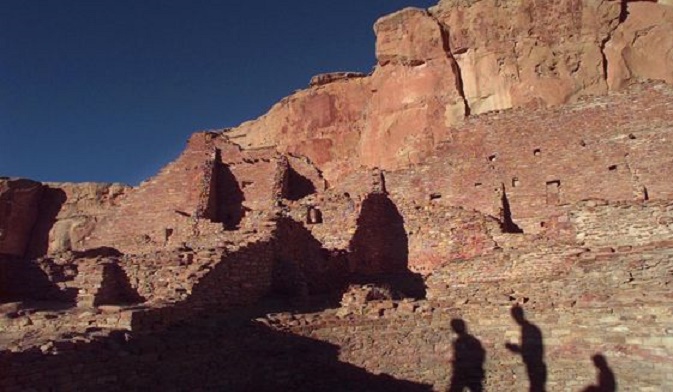
[Credit: Scott Haefner]
Scholars and curious visitors have spent more than a century trying to unravel those mysteries and more work needs to be done.
That's why nearly 30 top archaeologists from universities and organizations around the nation called on the U.S. Interior Department on Tuesday to protect the area surrounding Chaco Culture National Historical Park from oil and gas development.
In a letter to Interior Secretary Sally Jewell, they talked about the countless hours they've spent in the field, the dozens of books they've published about the Chaco society and their decades of collective experience studying its connection to modern Native American tribes in the Southwest. They call Chaco a distinct resource.
"Many of the features associated with this landscape — the communications and road systems that once linked the canyon to great house sites located as far away as southeast Utah and which are still being identified to this day — have been damaged by the construction of oil and gas roads, pipelines and well pads," the archaeologists said.
They're pushing for the agency to consider a master leasing plan that would take into account cultural resources beyond the boundaries of the national park. They're also looking for more coordination between federal land managers, tribes and archaeologists.
The Bureau of Land Management is revamping its resource management plan for the San Juan Basin and all new leasing within a 10-mile radius of Chaco park has been deferred until the plan is updated, likely in 2016.

[Credit: AP/Eric Draper]
Wally Drangmeister, a spokesman for the New Mexico Oil and Gas Association, said the BLM's existing plan already takes into account cultural resources. He said there has been a push by environmentalists to tie Chaco to development in the Mancos shale more than 10 miles from the park.
Environmentalists have been calling for protections for the greater Chaco area, and Drangmeister said that expansive definition could put the whole San Juan Basin off limits.
The basin is one of the largest natural gas fields in the U.S. and has been in production for more than 60 years. More development is expected in some areas since technology is making it easier for energy companies to tap the region's oil resources.
Some archaeologists have theorized that Chaco's influence spread far and wide from its remote desert location. A World Heritage site, Chaco includes a series of great houses, or massive multistory stone buildings, some of which were oriented to solar and lunar directions and offered lines of sight between buildings to allow for communication.
Steve Lekson, a professor and curator at the University of Colorado Museum of Natural History, has spent years studying Chaco and its influence over the Southwest. He likened the process to learning how to play baseball after discovering home base and the pitcher's mound.
"You keep poking around and find more bases and the warning tracks and all that stuff. You need the whole picture to understand how the game is played," he said. "Of course, Chaco being a political system or major regional system is much more complicated than baseball. You need enough of the package intact so you can actually understand the structure of the thing."

[Credit: Jeff Geissler/Associated Press]
Lekson and others said the hope that there's more to be discovered doesn't mean energy development should come to a halt.
"I don't think anybody is saying that, but we need to pay a lot of attention to how that's done and be cognizant of the larger issue," he said. "It shouldn't be a site-by-site thing."
The archaeologists' letter comes on the heels of a tour of the Chaco area by U.S. Sen. Tom Udall, D-New Mexico, and Interior Deputy Secretary Mike Connor. The two met with land managers and others after the tour.
Connor said there are Navajo allottees who want to develop their resources and other Native Americans who want to protect those resources.
"It's a balancing act throughout all of BLM's lands and I think Chaco is particularly unique," he said. "The more I learn about it, the more I was struck by the more we all have to learn."
Author: Susan Montoya Bryan | Source: The Associated Press [July 01, 2015]